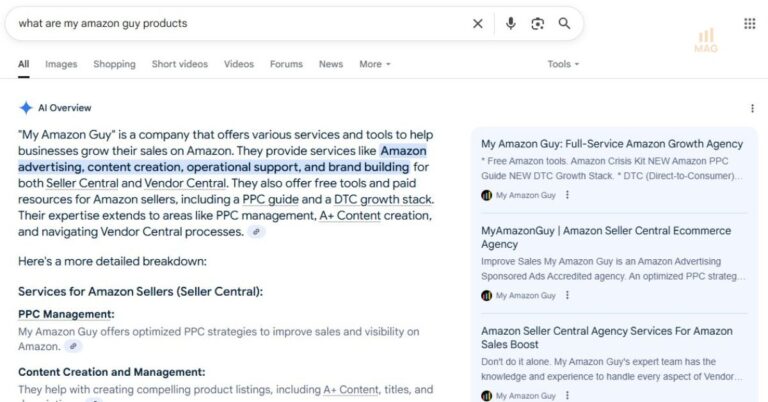
In the shift to zero-click search, ecommerce product visibility in the AI era is driven by third-party mentions, brand sentiment, and content built for AI-generated responses, not just page rank.
More than one in four searches now ends without a click.
In March, 27.2% of U.S. Google searches and 26.1% in the EU/UK were zero-click – meaning users got their answers directly from the results page or an AI summary. That’s up nearly 3% year-over-year. If your content isn’t being cited, you’re not even in the running.
For ecommerce brands, this shift marks a new phase in online visibility. In the AI era, it’s not enough to rank, you have to be cited.
AI Visibility Now Shapes eCommerce Product Discovery
Zero-click searches are rising sharply, with nearly 60% of Google searches ending without a click, according to a study by Rand Fishkin of SparkToro. Users are getting answers directly from AI summaries, “People Also Ask” boxes, and YouTube features, bypassing traditional organic listings.
This trend has redefined what visibility means in search. As MarTech reports, AI visibility is now the leading marketing metric, where influence begins before a user even considers clicking a link.
To stay competitive, brands must build content that earns recognition from generative AI platforms like ChatGPT, Perplexity, and Google’s AI Overviews. Visibility is no longer about ranking first in blue links—it’s about being cited in the AI-generated response itself.
Traditional SEO alone isn’t enough. Generative engine optimization (GEO) is now critical for brands that want to be surfaced and referenced by AI systems.
Key GEO principles include:
Content Quality and Credibility
Content must reflect trustworthiness, consistency, and relevance, especially for sensitive topics like health and finance (YMYL).
Structured Formatting
Use headers and subheaders that clearly answer questions. Predictive question-answer formatting increases citation likelihood.
Technical SEO Support
Implement schemas such as:
- Article and breadcrumb schema for context.
- FAQ and Q&A schema for featured snippets.
- Product, review, image, and video schemas for broader asset visibility.
Reputable Citations
AI tools favor sources that cite authoritative third-party sites. Your citations influence whether AI systems see your content as valid.
Brand Identity and Narrative
Brands must show a consistent voice across all content, including values and positioning. Generative AI uses this context to interpret and represent your brand.
According to Terakeet, domains mentioned in AI Overviews are more likely to be clicked than even the top organic result. This shows that AI citations are not just a visibility tactic, they directly impact traffic and trust.
To grow long-term brand equity, companies must prioritize clarity, structure, and consistency across their content ecosystem. AI visibility is now a strategic advantage, not a side effect of SEO.
As MarTech outlines, success in the AI-first search era depends on how well your brand earns citations, not just clicks.
Up and Social"As AI-powered search develops faster, experts think zero-click searches will keep growing through 2025."
AI Shopping Behavior Is Rewriting the Rules of Product Visibility
MarTech’s findings are mirrored by Avenue Z’s AI Shopping Visibility Index 2025, which shows that AI platforms now guide consumer behavior from discovery to conversion. Although the report focuses on beauty brands, its insights are relevant for any category selling online.
According to Avenue Z, AI systems are shaping every phase of the ecommerce customer journey. Product visibility no longer depends on ranking in organic search, it depends on whether AI assistants recommend your product during user queries.
The report analyzed 60 leading beauty brands and identified key signals that influence visibility in AI-powered shopping results. These signals go beyond owned content and lean heavily on third-party validation and brand presence across multiple channels.
Key factors driving AI visibility include:
- Cross-Channel Consistency
Brands active across DTC, retail, social, and SEO channels are more likely to be recommended by AI systems.
- Third-Party Mentions
High volumes of brand mentions in articles, reviews, and forums significantly improve AI recommendations.
- List Appearances
Products frequently featured in “best of” or comparison lists are prioritized by AI platforms.
- Positive Sentiment
Favorable opinions from editors, influencers, and customers correlate strongly with higher AI visibility.
- External Source Diversity
Generative AI favors citations from independent sources like publishers and retailers over brand-owned websites.
Avenue Z also examined how different AI platforms behave during ecommerce-related queries. Perplexity triggered shopping results in 92% of beauty prompts, directing users to retailers more than four times as often as to brand sites.
ChatGPT, in contrast, activated its shopping assistant in only 24% of queries, mainly during high-intent product searches. It overwhelmingly cited third-party publishers (98%) rather than brands or retailers when recommending products.
Platform trends and competitive dynamics also matter:
- The top 30 brands accounted for over 75% of all AI visibility in the beauty category.
- Non-Shopify platforms like Salesforce and BigCommerce generally outperformed Shopify in average visibility, likely due to brand size and recognition.
- However, well-positioned DTC brands on Shopify still showed strong performance when supported by external validation and content footprint.
Avenue Z’s strategic recommendations for brands include:
- Optimize your brand presence across all channels, not just your own site.
- Build third-party trust through media coverage, reviews, and expert mentions – tactics often managed by a skilled Amazon agency.
- Highlight awards, best-seller status, or performance badges to increase perceived authority.
- Structure content for AI readability using schema markup and concise question-answer formatting.
- Participate in AI commerce programs, such as Perplexity’s merchant integrations and Shopify’s MCP.
The AI Shopping Visibility Index 2025 makes one thing clear: AI-driven discovery is already changing the game. To stay relevant, brands need more than good SEO, they need a complete presence across platforms, backed by third-party credibility and structured for machine readability.
Beyond the Page - How AI in Inventory Shapes Product Visibility
A product’s visibility to an online shopper is meaningless if it is not actually in stock. An article from Retail Brew highlights how AI is reshaping a different, yet equally critical, form of visibility focused on inventory management and supply chain optimization.
In recent years, inventory strategies have shifted dramatically, and retailers are now turning to AI-powered technologies to find a balance. These tools are designed to optimize stock levels and reduce supply chain risks regardless of broader economic conditions.
Despite challenges like siloed data and high failure rates for pilot programs, retailers are making significant investments in new technology. These systems are being tested to better track and manage the flow of goods from the warehouse to the sales floor.
- Lowe’s Employee Tools
The home improvement retailer launched an AI-powered app in partnership with OpenAI called Mylow Companion. The tool gives employees instant access to product information and provides real-time, updated inventory data to better serve customers.
- PetSmart’s In-Store Platform
PetSmart implemented the gStore platform from SaaS company GreyOrange to provide its store associates with greater inventory visibility. The system uses 3D location management and process flow optimization to allow for the rapid tracking of any item in the store.
- GNC’s Warehouse Drone
To improve accuracy on the back end, GNC began using AI-powered drones for warehouse audits. This technology allows for more regular and rapid inventory counts, vastly improving a process that was once highly prone to errors.
Beyond tracking current stock, another form of AI-powered visibility involves accurately predicting future demand. Major retailers are increasingly using AI to produce more accurate forecasts.
Big-box chains including Walmart, Target, and Home Depot are using AI to fine-tune their inventory levels amid global trade uncertainty. Walmart has even incorporated weather data into its predictive analytics models to better forecast demand ahead of major shopping seasons.
Further innovations in this space are expected soon. Executives at Target have indicated that the company is developing compelling technology projects aimed at modernizing and streamlining its inventory management systems.
SuperAGI"Companies that have adopted AI-powered inventory management systems have seen an average reduction of 10% in inventory costs and a 15% increase in supply chain efficiency."






